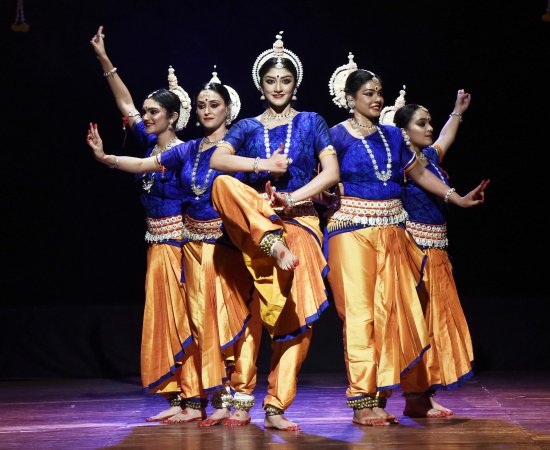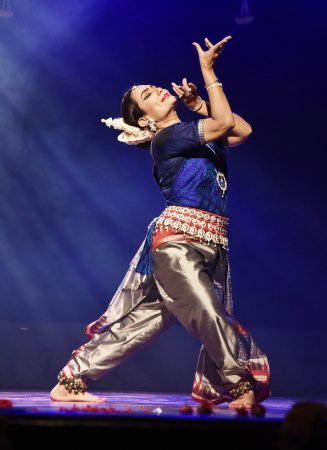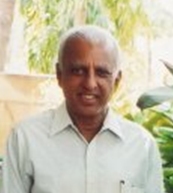
|   |

|   |
Shishir Chhanda Festival - Satish Suri e-mail:satishism@yahoo.co.in Photos:Shandilya Srivatsa December 11, 2023 Sarita Mishra's Adyasha Foundation presented a festival of engaging performances by talented and diverse artistes on 11th November at J.S.S. Auditorium, Bangalore. The first performance of the evening was Mangalacharan, a traditional Odissi dance honouring Lord Jagannath. Dancers Vedashree, Sanvi, Stutee, Mitali, Kavya, Ashavari, Sonakshi, Sriya, Lopa, Pravas, Samaira, Namrata, Ahana, Sonal, Aditi and Asba portrayed divine attributes through graceful movements and expressions, accompanied by enchanting music and chants.  Sarita Mishra's disciples Following that, the Megh Pallavi showcased the skills of dancers Sai Srishti Rath and Esha Anuj Singhal. Their performance, rich in Odissi's intricate footwork and expressive gestures, eloquently depicted the beauty and emotions associated with clouds. Chandana charchita is a beautiful Odia song sung by Namita Agarwal, a renowned Odia singer. The song depicts the love and devotion of Radha for Krishna. It was performed by three graceful dancers Vedashree, Saanvi and Kavya. The dancers Sai Srishti, Manasi, Aditi, Asba, Sriya, Pravas and Esha executed Sarita Mishra's choreography with skill, showcasing their proficiency in conveying the essence of "Mani bimane Govinda." "Shringapuradheeshwari Sharadhe" is a traditional song, written by Padmacharan that praises the goddess of learning and arts, Saraswati. In this rendition, the song has been given a new musical and visual interpretation by a team of talented artistes to suit the Odissi format.Sukanta Kundu and Srinibas Satpathy have composed a new music arrangement that retains the original melody but adds their creative flair to it. Bijay Kumar Barik has created and performed the rhythm composition that matches the new music arrangement and enhances its appeal. Sarita Mishra has choreographed the dance composition that expresses the meaning and emotion of the song. The dancers-Shubha Nagarajan, Sahana Kakarla, Chandana Veejay Keerthi, Deepa Param, Vivek Shridhar, Sai Srishti Rath, and Esha Anuj Singhal-executed the choreography with skill and elegance, bringing the song to life through their collective talents. Sarita Mishra's rendition of "Dheera sameere," one of Jayadeva's ashtapadis, was a captivating display of the song's sensual mood with complex emotions and subtleties of the lyrics. Her gestures and postures were a perfect blend of elegance and accuracy, creating a visual story that matched the poetic words and touched the viewers.  Sarita Mishra The highlight was the thematic "Ahe neela shaila", indeed a deeply moving and spiritually resonant Odia bhajan attributed to Bhakta Salabega, a devout Muslim devotee of Lord Jagannath. The story surrounding Salabega's unwavering devotion and the miraculous stop of the chariot during Rath Yatra in front of his hut exemplifies the unifying power of faith and the divine's acceptance beyond religious boundaries. The verses in the bhajan evoke powerful imagery and prayers to Lord Jagannath, depicting the might and benevolence of the divine. The references to the blue-shaded mountain symbolize Lord Jagannath's strength and ability to overcome adversities, much like how the Lord protected and rescued beings in various mythological tales. The bhajan's lyrics express surrender and longing for the divine grace of Lord Jagannath, seeking solace and relief from worldly sorrows. Salabega's devotion to Lord Jagannath, despite being of a different faith, emphasizes the universality of spiritual connection and the transcendence of religious barriers in the pursuit of divine love and devotion. The continuation of the tradition where the chariot stops at Salabega's Mazar annually during the Rath Yatra stands as a poignant reminder of the harmonious coexistence of diverse beliefs and the inclusive nature of spirituality. The performers portrayed the various episodes to provide a refreshing and absorbing flow to the storyline, bringing the essence of Salabega's devotion, trust, and surrender to Lord Jagannath to life in a captivating manner. The group of talented performers contributed significantly to the emotional resonance, adding depth and richness to the storytelling, making it a delightful and engaging experience. It's wonderful to see such artistic endeavours that bring stories of devotion and spirituality to life in a way that touches hearts and minds. The performance was a result of the combined efforts of four talented artistes. Srinibas Satpathy composed the music with melodies that matched the mood of the dance. Bijay Kumar Barik arranged the rhythms that harmonized the music and the movement. Dr. Srinibas Ghatuary wrote the dialogues that added narrative depth to the themes. Sarita Mishra choreographed the dance with expressive and dynamic movements. Together, they created a memorable Odissi presentation that delighted the audience.  Surya Rao The performance of 'The 11th Head of Ravana' by Surya Rao is a remarkable exploration of Ravana's psyche and motivations, as he faces his inevitable defeat by Lord Rama. Surya Rao presents a unique portrayal of Ravana, showcasing his contemplation of impending death at the hands of Lord Rama. The storyline delves into Ravana's self-proclaimed invincibility due to a boon obtained from Lord Shiva, claims he is Ravaneswara, signifying his belief that he orchestrated his demise by luring Rama to confront him by kidnapping Sita disguised as a mendicant seeking alms. The performance utilizes a fusion of movement styles, incorporating elements from Kuchipudi, Yakshagana, and martial arts. This eclectic blend creates a powerful and captivating rendition, leaving a profound impact on the audience, particularly during Ravana's final duel with Rama. One intriguing aspect of the performance is the depiction of Ravana's expression of love for Mandodari, specifically the story of Mandodari as a frog transformed into a princess. This narrative element adds depth and complexity to Ravana's character, showcasing his emotions and vulnerabilities amidst his perceived strength and power.  Tridhara The concluding performance featured a talented trio of Bharatanatyam artistes: Sheela Chandrasekhar, Soundarya Srivatsa, and Shoba Shashikumar. Their performance explored D.V. Gundappa's 'Manku Thimanna Kagga,' delving into the attributes of a flower and its diverse significance. The verses beautifully depict the multifaceted roles of a flower: to a devotee, it symbolizes reverence at the feet of the deity; to a lover, it represents an adornment; for the seller, its value lies in providing sustenance by being sold for daily bread. Furthermore, the flower stands as a silent witness in nature, embodying beauty, colour, and fragrance. The trio through their consummate artistry in both rhythm and expression, effectively portrayed the various facets of the flower's significance as described in the verses. The solo performances that followed depicted three shades of sringara. Soundarya Srivatsa's solo performance was a captivating depiction of the sringara rasa, focusing on an ashtapadi titled "Naatha Hare." In this piece, Soundarya portrayed a Sakhi assuming the role of a messenger, pleading with Krishna on behalf of Radha. Radha, tormented by separation and engulfed in despair, expresses her anguish through the Sakhi, beseeching Krishna to come and alleviate her distress. Soundarya's performance was exquisite, capturing the depth of Radha's emotions and her yearning for Krishna, presenting a poignant portrayal of Radha's anguish and longing for reunion. Soundarya's artistry effectively immersed the audience in the emotional journey of Radha portrayed through the Sakhi's plea to Krishna. Shobha Shashikumar's performance of 'Swayamdootha,' a composition by Dr. Shatavadhani Ganesh, depicted the dilemma of a Nayika in conveying a message to her beloved. In the piece, the Nayika contemplates various elements-fire, water, air, and even the birds of nature-as potential messengers for her communication. However, upon reflection, she realizes that none of these elements are suitable for conveying her heartfelt message. Ultimately, she decides that the most authentic and sincere way to communicate with her love is through the language of her own heart. Her performance conveyed the Nayika's journey that genuine communication stems from the sincerity of one's own emotions and feelings. Yashodhara laments over the departure of Siddhartha who leaves in the middle of the night to seek enlightenment. "He did not even wake me up to say goodbye and did not even show his face. What could be the reason for his anger? What have I done? As I slept securely with my head on his chest, how could he desert me? Why are the clouds and sun so happy? Am I to wail on the floor like a creeper whose support has disappeared? Will there ever be light in this house at dusk? Can the door tell me which way my husband left? Oh, my eyes couldn't warn me with a dream?" Sheela Chandrasekhar concluded the performance with a poignant composition by Basavaraj Appa Rao, choreographed by Bragha Bessell. The piece depicted the lament of Yashodhara, Siddhartha Gautama's wife, upon discovering his unannounced departure in the middle of the night to seek enlightenment. Yashodhara's lamentation and sorrow over Siddhartha's departure were effectively conveyed through the depth of her emotions.  Bangalore based Satish Suri is an avid dance rasika besides being a life member of the Music and Arts Society. |